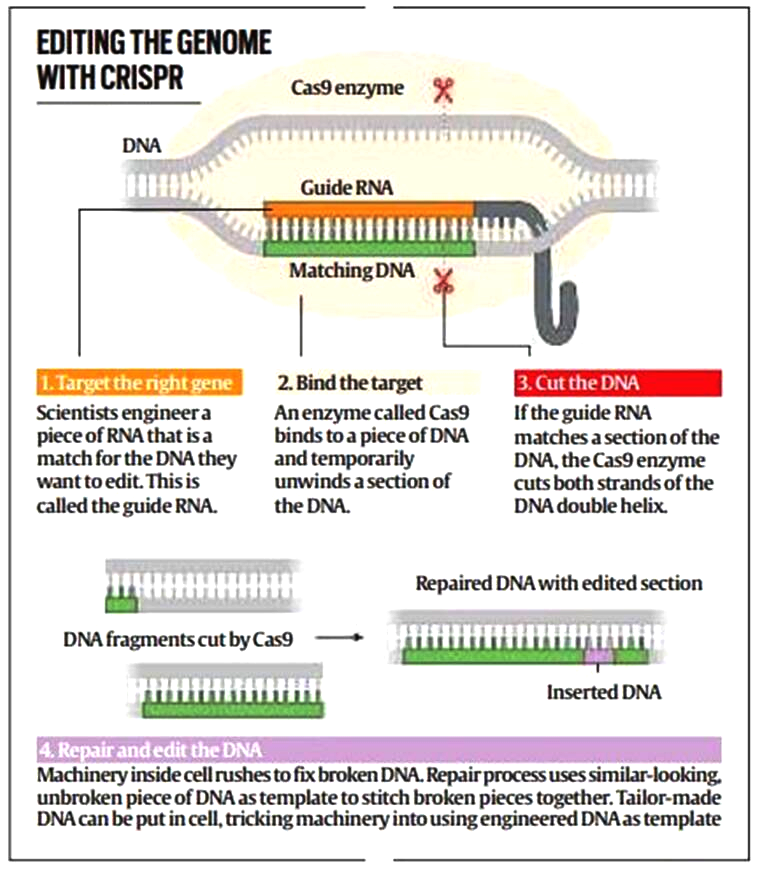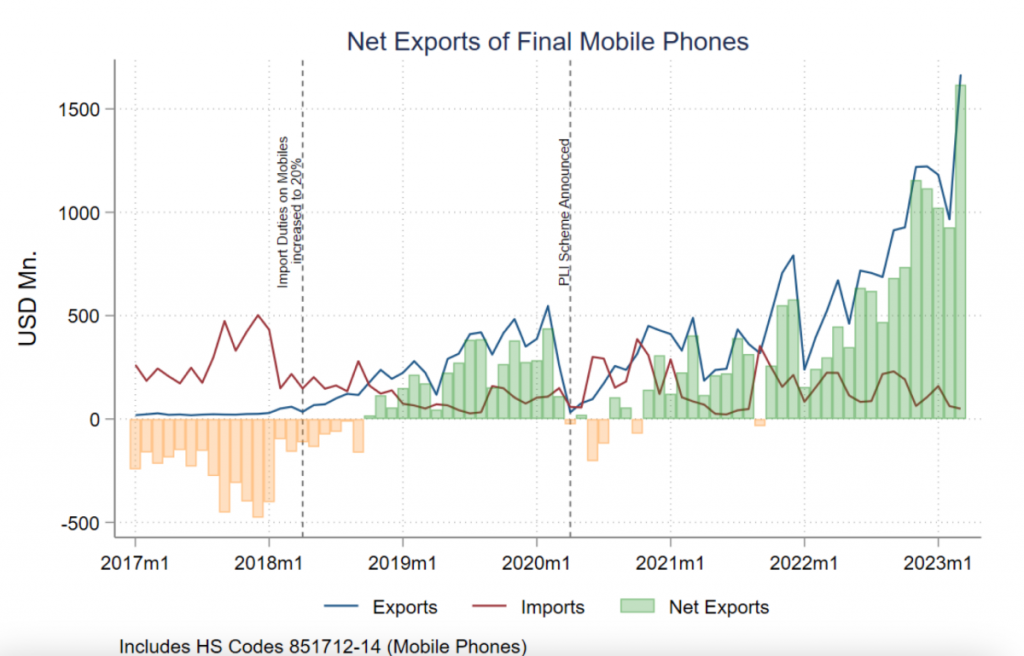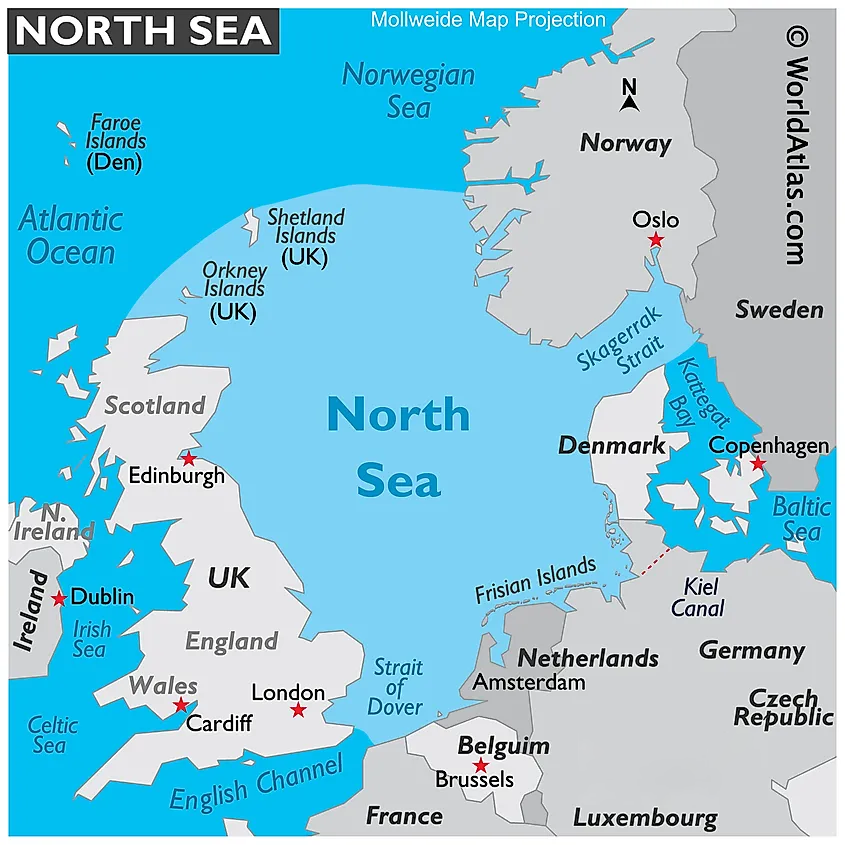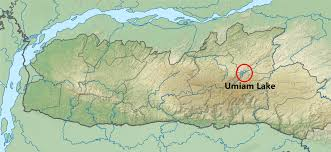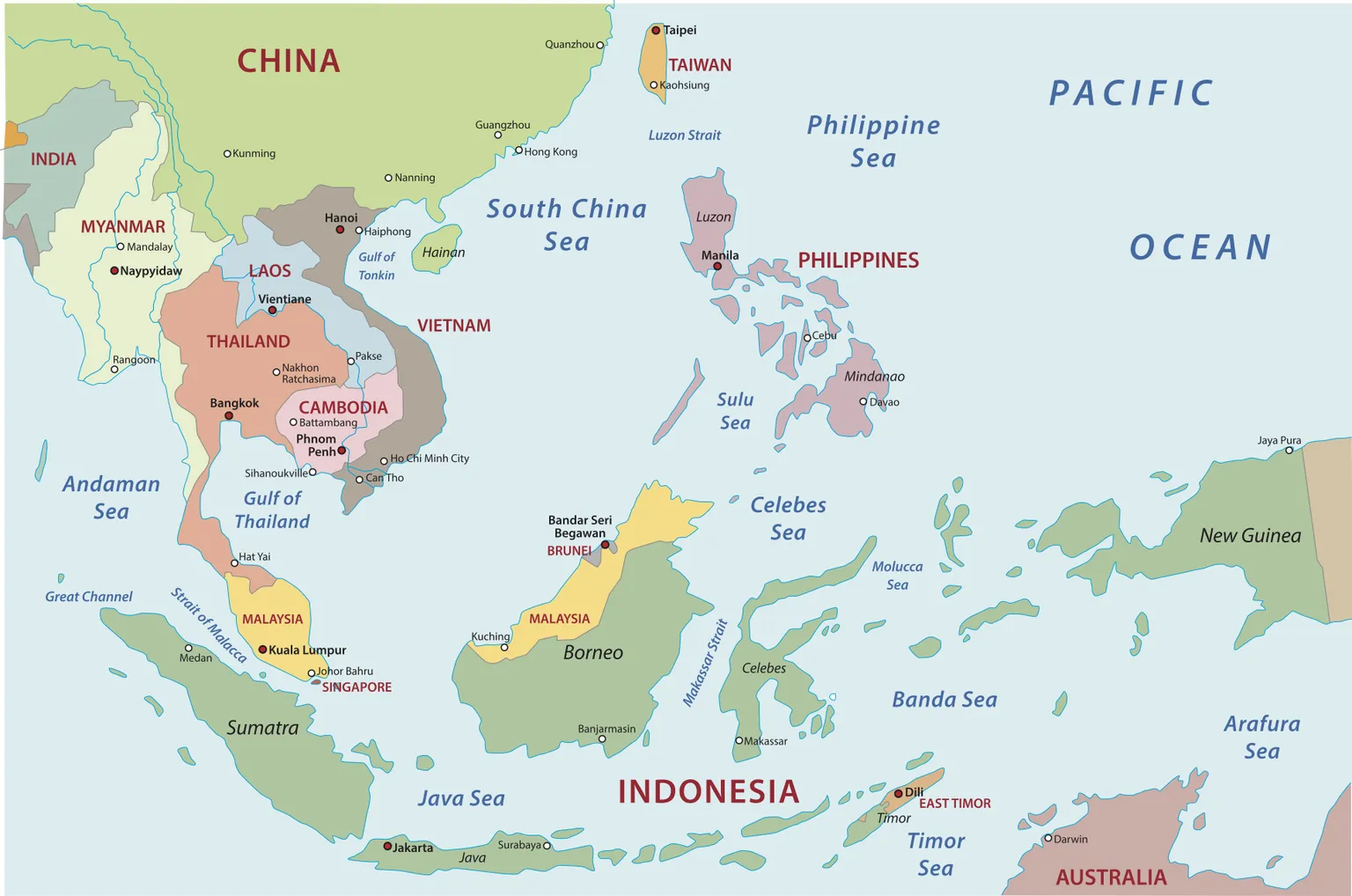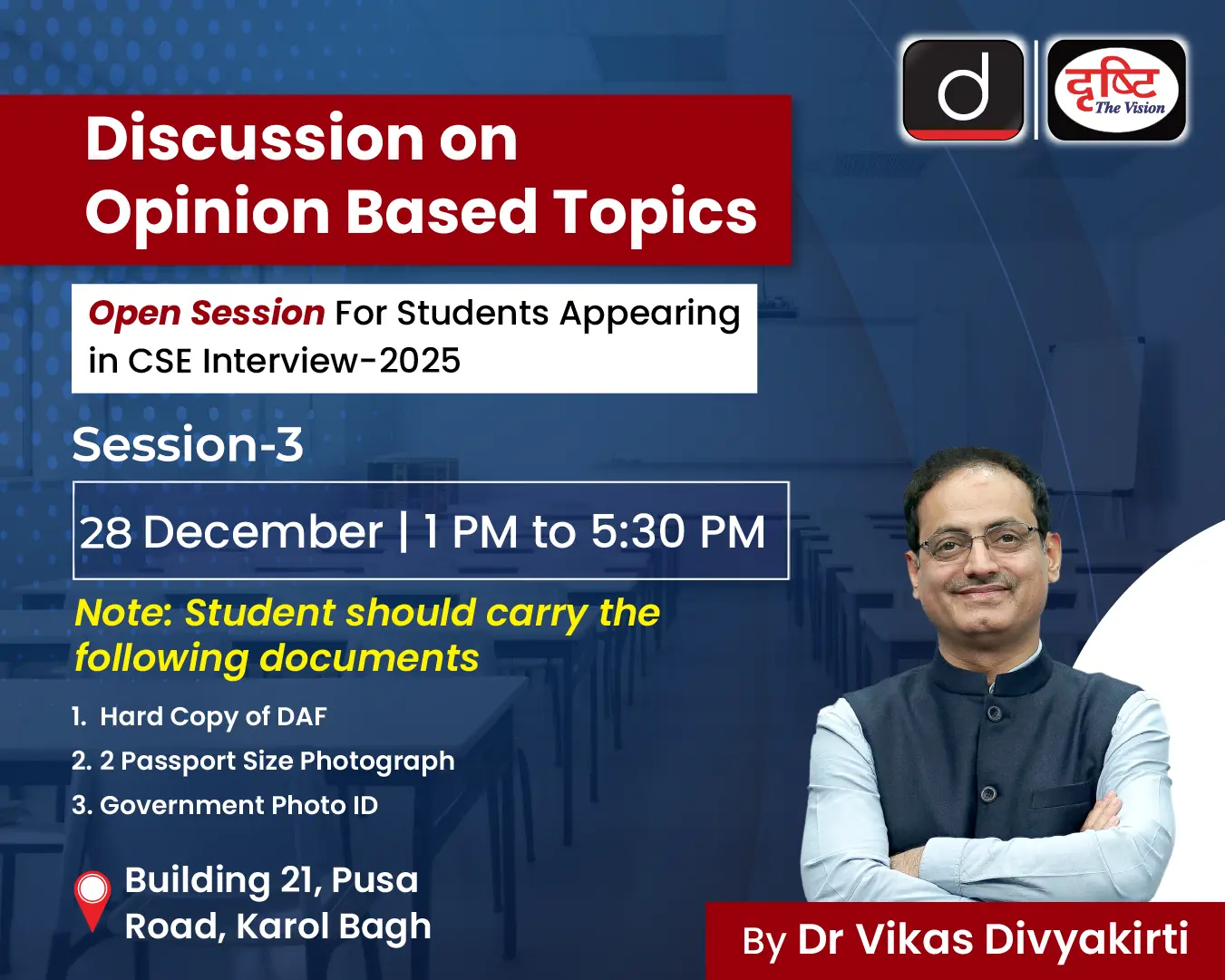Science & Technology
Gene Editing in Mustard Breeding
For Prelims: Gene editing, Mustard in India, CRISPR/Cas9, Glucosinolates, Genetic Engineering Appraisal Committee, DNA, Genetically modified (GM) plants
For Mains: Significance of Gene Editing in Mustard Breeding, Difference in Genome Editing and Genetic Modification.
Why in News?
Indian scientists have developed the first ever low-pungent mustard that is pest and disease-resistant. It is based on CRISPR/Cas9 gene editing, while being non-GM and transgene-free.
What is the Significance of Gene Editing in Mustard Breeding?
- Background:
- Traditional mustard seeds (Brassica juncea) that are grown in India contain about 120-130 parts per million (ppm) of compounds called glucosinolates, which are a group of sulphur and nitrogen-containing compounds contributing to the characteristic pungency of their oil and meal.
- These compounds serve as natural defenders, protecting the plant from pests and diseases.
- In comparison, canola seeds have much fewer glucosinolates, around 30 ppm. These lower levels let the canola oil and meal have a specific pleasant taste.
- Oilseeds yield oil for cooking, and their leftover meal, a protein-rich ingredient, is used in animal feed. Rapeseed meal, rich in glucosinolates, is fed to livestock but requires mixing with grass and water.
- High glucosinolates are also known to cause goiter (swelling of neck) and internal organ abnormalities in livestock.
- Scientists have been working on a goal to develop mustard seeds that have fewer glucosinolates, similar to canola seeds.
- However, reducing glucosinolates in mustard seeds can weaken the plant's overall ability to defend itself against pests and diseases, which presents a challenge.
- Traditional mustard seeds (Brassica juncea) that are grown in India contain about 120-130 parts per million (ppm) of compounds called glucosinolates, which are a group of sulphur and nitrogen-containing compounds contributing to the characteristic pungency of their oil and meal.
- The Role of Gene Editing in Mustard Breeding:
- Scientists directed their efforts toward modifying specific genes known as glucosinolate transporter (GTR) genes.
- These genes play a crucial role in how glucosinolates, important compounds in mustard seeds, build up.
- To achieve this modification, they employed a gene-editing tool called CRISPR/Cas9, which works like precision scissors to alter gene sequences accurately.
- In a particular mustard variety named 'Varuna,' the researchers focused on 10 out of the 12 GTR genes.
- Through these genetic modifications, they deactivated the proteins produced by these genes, resulting in a significant reduction in glucosinolate levels within the seeds.
- Scientists directed their efforts toward modifying specific genes known as glucosinolate transporter (GTR) genes.
- Implications of Gene Editing on Plant Defense and Pest Resistance:
- The modified mustard plants showcased glucosinolate levels in their seeds that were lower than the 30 ppm threshold set for canola-quality seeds.
- Interestingly, the leaves and the walls of the pods around the seeds displayed higher amounts of glucosinolates.
- This increase was attributed to a disruption in the transport of these compounds. This heightened accumulation of glucosinolates in the leaves and pods plays a crucial role in bolstering the plant's ability to resist pests.
- As a result of these genetic modifications, the edited mustard lines exhibited robust defense mechanisms against both fungal and insect pests.
What is the Difference between Genome Editing and Genetic Modification?
- The GTR genes-edited mustard lines are the result of genome editing (GE), distinguishing them from genetically modified (GM) plants.
- Unlike GM crops, where foreign genes are introduced, like those of the Bacillus thuringiensis bacteria in cotton or Bar-Barnase-Barstar (isolated from other soil bacteria) in the GM hybrid mustard (DMH-11), GE focuses on modifying the genes that already exist without adding new genetic material.
- The recently developed mustard lines are completely free of transgenes and do not possess any foreign genes.
- It's important to note that the CRISPR/Cas9 enzyme, which is employed for gene editing, is not present in the final genome-edited plants.
- This sets them apart from transgenic GM crops, where the introduced genes can persist.
- Regulatory Landscape and Future Prospects:
- In India, the regulation of genetic modification is stringent and necessitates approval from the Genetic Engineering Appraisal Committee (GEAC) under the Ministry of Environment, Forest and Climate Change.
- However, an official memorandum from the MoEFCC has exempted genome-edited (GE) plants that don't incorporate foreign DNA from requiring GEAC approval for open field trials.
- The newly developed genome-edited mustard lines are poised to undergo open field trials, having obtained clearance from the Institutional Bio-safety Committee (IBSC).
- The potential benefits of these advancements are substantial, particularly because India currently imports a significant amount of edible oils, incurring substantial costs annually.
- These innovations hold the promise of enhancing domestic oilseed production by bolstering crop yields, resistance to pests, and product quality.
- This progress could ultimately contribute to diminishing the country's reliance on imported vegetable oils.
- In India, the regulation of genetic modification is stringent and necessitates approval from the Genetic Engineering Appraisal Committee (GEAC) under the Ministry of Environment, Forest and Climate Change.
What is the Status of Mustard Cultivation in India?
- Mustard is India’s most widely-cultivated oilseed crops, planted annually on 9 million hectares area respectively. It is grown in Rabi season.
- Its higher average oil extractable content (38%) makes mustard a good “oilseed” crop, while a source of both fat for humans and protein for animals.
- Mustard is an important cash crop for farmers in Rajasthan, Haryana, Madhya Pradesh and Uttar Pradesh, among others.
What is CRISPR Cas9 Technology?
- CRISPR-Cas9 is a groundbreaking technology that empowers geneticists and medical researchers to modify specific portions of the genome.
- This is achieved through the precise removal, addition, or modification of segments within the DNA sequence.
- The CRISPR-Cas9 system involves two important components that bring about changes or mutations in DNA. These components are:
- An enzyme known as Cas9, which acts like a pair of precision "molecular scissors."
- Cas9 has the ability to cut the two strands of DNA at a specific spot within the genome. This precise cutting enables the addition or removal of segments of DNA.
- A segment of RNA referred to as guide RNA (gRNA). This consists of a small, pre-designed RNA sequence.
- This RNA sequence is embedded within a longer RNA structure. The lengthier part of the RNA attaches itself to DNA, while the specific sequence within it functions as a "guide" for Cas9.
- This guidance mechanism directs the Cas9 enzyme to the exact location in the genome where it should make the cut.
- This ensures that the cutting action of the Cas9 enzyme takes place accurately at the intended point in the genome.
- An enzyme known as Cas9, which acts like a pair of precision "molecular scissors."
UPSC Civil Services Examination, Previous Year Question (PYQ)
Prelims
Q. What is Cas9 protein that is often mentioned in news? (2019)
(a) A molecular scissors used in targeted gene editing
(b) A biosensor used in the accurate detection of pathogens in patients
(c) A gene that makes plants pest-resistant
(d) A herbicidal substance synthesized in genetically modified crops
Ans: (a)
Mains
Q. What are the research and developmental achievements in applied biotechnology? How will these achievements help to uplift the poorer sections of society? (2021)


Governance
PM-DevINE and NESIDS Schemes
For Prelims: PM-DevINE, PM Gati Shakti
For Mains: Significance of North East for India, Challenges Related to North East India
Why in News?
Recently, The Prime Minister's Development Initiative for North Eastern Region (PM-DevINE), designed to bolster North-East India's development, has undergone crucial revisions to align with the region's needs and aspirations.
- These new guidelines govern all PM-DevINE projects effective from 12th October 2022 onwards.
- Additionally, the Ministry of Development of the North Eastern Region(MDoNER) releases new Scheme Guidelines for implementing Cabinet-approved North East Special Infrastructure Development Scheme (NESIDS) during the 15th Finance Commission's balance period (2022-2026).
What are the Revised Guidelines of the PM-DevINE Scheme?
- Project Oversight and Governance:
- MDoNER will oversee project selection, approval, and monitoring in consultation with State Governments, North Eastern Council (NEC), and concerned Central Ministries, with implementation through NEC or Central Ministries/agencies.
- The guidelines outline the process, including project identification, selection, DPR preparation, sanction, fund release, monitoring, and completion.
- Empowered Inter-Ministerial Committee (EIMC):
- Establishment of EIMC to oversee various functions within PM-DevINE.
- Chaired by the Secretary of the MDoNER.
- State Level Empowered Committee (SLEC):
- Creation of SLEC at the State level for project review and approval.
- Composition of SLEC including Chief Secretary, relevant Secretaries, and representation from NEC.
- Regarding Project Selection:
- North Eastern States must establish Gati Shakti implementation mechanisms like Empowered Group of Secretaries, Network Planning Group, and Technical Support Unit, along with notifying a State Logistics Policy and updating Gati Shakti National Master Plan data layers, including land revenue maps.
- States not meeting these criteria won't receive new PM-DevINE project sanctions from 2023-24 onwards.
- North Eastern States must establish Gati Shakti implementation mechanisms like Empowered Group of Secretaries, Network Planning Group, and Technical Support Unit, along with notifying a State Logistics Policy and updating Gati Shakti National Master Plan data layers, including land revenue maps.
What is PM-DevINE?
- The Genesis of PM-DevINE:
- The PM-DevINE scheme as a Central Sector scheme, was introduced as a part of the Union Budget 2022-23.
- The Cabinet granted approval for the PM-DevINE scheme on 12th October 2022. It has been granted 100% Central funding, ensuring that resources are directly allocated to the development initiatives.
- It will be implemented by the Ministry of Development of the Northeast Region.
- Objectives of PM-DevINE:
- Infrastructure Development: In line with the spirit of PM GatiShakti, PM-DevINE aims to fund infrastructure projects in a cohesive manner, ensuring seamless connectivity and accessibility across the NER.
- Supporting Social Development Projects: Recognizing the unique needs and challenges of the NER, the scheme endeavours to support social development projects that address critical issues and improve the overall quality of life for the region's inhabitants.
- Empowering Youth and Women: PM-DevINE seeks to create livelihood opportunities specifically targeting the youth and women of the NER, enabling them to participate actively in the region's development and progress.
- Ineligible Projects under PM-DEVINE:
- Projects providing long-term individual benefits or "Direct Benefit Transfer" elements.
- Projects for administrative buildings of government offices/agencies or institutional needs.
- Sectors covered by other MDoNER schemes and those specified in the Negative List by the Ministry of DoNER.
What is the North East Special Infrastructure Development Scheme (NESIDS)?
- NESIDS, a central sector scheme with 100% central funding, receives a renewed approved outlay of Rs. 8139.50 crore for 2022-23 to 2025-26.
- The scheme encompasses two components: NESIDS-Road and NESIDS-Other Than Road Infrastructure (OTRI).
- The merger of the former North East Road Sector Development Scheme (NERSDS) into NESIDS-Road led to the formulation of fresh guidelines.
- NESIDS aims to foster infrastructure development, especially connectivity, in identified sectors across the North Eastern States.
What are Other Initiatives Related to the Development of the Northeast Region?
- North Eastern Council (NEC)
- Connectivity Projects: Kaladan Multi-Modal Transit Project (Myanmar) and Bangladesh-China-India-Myanmar (BCIM) Corridor.
- Bharatmala Pariyojana ( 5,301 km road stretches in NER for improvement)
- North East has been kept as a priority area under RCS-UDAN (to make flying more affordable).
UPSC Civil Services Examination, Previous Year Questions (PYQs)
Q. Cross-border movement of insurgents is only one of the several security challenges facing the policing of the border in North-East India. Examine the various challenges currently emanating across the India- Myanmar border. Also, discuss the steps to counter the challenges. (2019)


Indian Economy
Production Linked Incentive Scheme
For Prelims: PLI Scheme for Electronic Manufacturing, Self-Sufficiency, Auto components, WTO Rules.
For Mains: PLI Scheme -Significance and Issues.
Why in News?
Recently, a debate has emerged over the effectiveness of India's Production-Linked Incentive (PLI), an Electronics Manufacturing scheme, suggesting it generates import-dependent assembly jobs rather than fostering Self-Sufficiency in manufacturing and economic growth.
What is the Production Linked Incentive Scheme (PLI)?
- About:
- The PLI scheme was conceived to scale up domestic manufacturing capability, accompanied by higher import substitution and employment generation.
- Launched in March 2020, the scheme initially targeted three industries:
- Mobile and allied Component Manufacturing
- Electrical Component Manufacturing and
- Medical Devices.
- Later, it was extended to 14 sectors.
- In the PLI scheme, Domestic and Foreign companies receive financial rewards for manufacturing in India, based on a percentage of their revenue over up to five years.
- Targeted Sectors:
- The 14 sectors are mobile manufacturing, manufacturing of medical devices, automobiles and auto components, pharmaceuticals, drugs, specialty steel, telecom & networking products, electronic products, white goods (ACs and LEDs), food products, textile products, solar PV modules, advanced chemistry cell (ACC) battery, and drones and drone components.
- Incentives Under the Scheme:
- The incentives given, are calculated on the basis of incremental sales.
- In some sectors such as advanced chemistry cell batteries, textile products and the drone industry, the incentive to be given will be calculated on the basis of sales, performance and local value addition done over the period of five years.
- The emphasis on R&D investment will also help the industry keep up with global trends and remain competitive in the international market.
- The incentives given, are calculated on the basis of incremental sales.
- Success in Smartphone Manufacturing:
- In FY 2017-18, mobile phone imports were USD 3.6 billion, while exports were a mere USD 334 million, resulting in a -USD 3.3 billion trade deficit.
- By FY 2022-23, imports reduced to USD 1.6 billion, while exports surged to nearly USD 11 billion, yielding a positive net exports of USD 9.8 billion.
What are the Issues with the PLI Scheme?
- Assembly vs. Value Addition:
- The subsidy in the scheme for Mobile and allied Component Manufacturing is paid only for finishing the phone in India, not on how much value is added by manufacturing in India, turning out that very little apart from assembly is done in India.
- So India still imports much of what goes into the mobile phones.
- WTO Constraints and Limited Value Addition:
- WTO rules prevent India from tying PLI subsidies to domestic value addition.
- Although India's aspiration to make chips is sound, chips are complex components.
- The absence of significant domestic value addition likely stems from these constraints.
- Vague Disbursal of Incentives:
- While an Empowered Committee has been formed to oversee the scheme and handle fund disbursement for different sectors, the process of awarding incentives lacks clarity.
- There are no well-defined criteria or standardized parameters that ministries and departments use to determine the allocation of these incentives, raising concerns about the fairness and effectiveness of the scheme.
- Lack of a Centralized Database:
- The lack of a centralized database that captures information like increase in production or exports, number of new jobs created etc. make the evaluation process an administrative complexities.
- This information ambiguity impacts transparency and can lead to malfeasance, further widening the fault lines and weakening the policy structure.
Way Forward
- The government must assess PLI's effectiveness, considering job creation, cost per job, and reasons for limited success.
- Extending the scheme to new sectors requires understanding its limitations and addressing underlying issues.
UPSC Civil Services Examination, Previous Year Questions (PYQs)
Q. Consider, the following statements : (2023)
Statement-I : India accounts for 3.2% of global export of goods.
Statement-II : Many local companies and some foreign companies operating in India have taken advantage of India's ‘Production-linked Incentive’ scheme.
Which one of the following is correct in respect of the above statements?
(a) Both Statement-I and Statement-II are correct and Statement-II is the correct explanation for Statement-I
(b) Both Statement-I and Statement-II are correct and Statement-II is not the correct explanation for Statement-I
(c) Statement-I is correct but Statement-II is incorrect
(d) Statement-I is incorrect but Statement-II is correct
Ans: (d)
Exp:
- According to the recent WTO’S Global Trade Outlook and Statistics report, India accounts for 1.8 % of global exports of goods. Hence, statement 1 is not correct.
- The ‘Production Linked Initiative’ (PLI) scheme offers companies incentives on incremental sales from products manufactured in India. It aims to attract foreign companies to set up units in India while encouraging local companies to expand their manufacturing units, generate more employment, and reduce the country's reliance on imports. Hence, Statement 2 is correct.


Biodiversity & Environment
UK’s North Sea Drilling
For Prelims: UK’s North Sea Drilling, North Sea, 1958 Geneva Convention, U.K. Parliament's Continental Shelf Act of 1964, Net-Zero Emissions.
For Mains: UK’s North Sea Drilling and its Environmental Concerns.
Why in News?
Recently, The Prime Minister of the UK has endorsed plans for additional fossil fuel drilling off the British coast in the North Sea, aiming at enhancing Britain's energy independence, and has raised questions about the U.K.'s commitment to its climate goals.
- The North Sea Transition Authority (NTSA), responsible for regulating the industries for drilling, is overseeing the 33rd offshore oil and gas licensing round.
What is the Evolution of North Sea Drilling?
- About North Sea:
- The North Sea is located in northwest Europe. It is bordered by several countries, including Norway to the east and north, Sweden, Denmark, Germany, the Netherlands and Belgium, France and the United Kingdom.
- It is connected to the Atlantic by the Strait of Dover and the English Channel and opens directly onto the ocean between the Orkney and Shetland islands and between the Shetland Islands and Norway.
- History
- The 1958 Geneva Convention on the Continental Shelf was the first international legislation to establish the rights of countries over the continental shelves adjacent to their coastlines and paved the way for exploration in the North Sea.
- The U.K. Parliament's Continental Shelf Act of 1964 solidified the country's jurisdiction over oil and gas resources beneath the seabed near its shores.
- British Petroleum (BP) secured the first exploration license in the U.K. North Sea in 1964, leading to the discovery of natural gas the following year.
- However, drilling operations faced setbacks, notably the collapse of the BP-operated Sea Gem drilling rig in 1965.
- Subsequently, commercial oil was discovered in the Forties Field, east of Aberdeen, Scotland in 1970, and the North Sea witnessed increased exploration efforts by various companies in the following decades.
- Present Need of UK:
- The UK emphasized that even after achieving Net-Zero Emissions by 2050, a significant portion of the U.K.'s energy needs, about a quarter, would still be reliant on oil and gas.
- The Prime Minister of UK argued that it is preferable to meet these needs using domestic supplies rather than depending on potentially unreliable sources from other nations.
- Despite the U.K.'s commitment to achieving net-zero emissions by 2050, concerns are raised about its adherence to climate targets.
- The Climate Change Committee (CCC) reported in its March 2023 Progress Report that the U.K. had not adequately prepared for climate change under the second National Adaptation Programme.
What are the Environmental Concerns Surrounding Offshore Drilling?
- Oil Spills:
- Offshore drilling operations carry the risk of oil spills, which can have catastrophic effects on marine ecosystems and wildlife. Spilled oil can coat birds, marine mammals, and fish, leading to suffocation, reduced insulation, and impaired ability to find food.
- Marine Ecosystem Disturbance:
- The physical presence of drilling platforms, pipelines, and other infrastructure can disrupt marine habitats.
- The noise and vibrations from drilling operations can harm marine life by disrupting communication, navigation, and breeding patterns.
- Biodiversity Impact:
- The construction of drilling structures can damage underwater habitats, such as coral reefs and seagrass beds, which serve as crucial breeding and feeding grounds for marine species.
- Climate Change:
- Extracting and burning fossil fuels obtained from offshore drilling contributes to greenhouse gas emissions, exacerbating global climate change.
- Offshore drilling also warms oceans, leading to sea-level rise and disruption of ocean currents.
- Resource Depletion:
- Intensive offshore drilling can deplete oil and gas reserves, leading to increased pressure to explore new areas, often in environmentally sensitive regions.
- Acidification:
- Carbon dioxide released from burning fossil fuels is absorbed by oceans, leading to ocean acidification. This acidification harms marine life, particularly organisms with calcium carbonate shells or skeletons, such as coral reefs and shellfish.


Social Justice
Changing Youth Concerns and Aspirations
For Prelims: Youth in India 2022 Report, Y20 Summit, Unemployment, Agricultural productivity, Demographic Dividend
For Mains: Opportunities and Challenges Related to Youth Population in India
Why in News?
In the ever-evolving landscape of youth concerns and aspirations, a recent survey conducted by Lokniti-CSDS across 18 states in India sheds light on the shifting priorities of the young population.
- The survey highlights the rising prominence of unemployment and price rise as pressing issues, the intersection of these concerns with economic classes and gender, and the evolving preferences in job aspirations.
What are the Major Highlights of the Survey?
- Unemployment, Price Rise and Gender Disparity:
- A 7% point increase in the share of respondents identifying price rise as a primary concern.
- 40% of highly educated respondents (graduate and above) pointing to unemployment as their most pressing concern.
- 27% of non-literate individuals expressed concern about unemployment, attributed to their flexibility in undertaking various job opportunities.
- Poverty and price rise emerged as more prominent issues for young women, regardless of their economic background.
- Occupational Diversity: Insights into Youth Employment:
- Almost half (49%) of the respondents were engaged in some form of work.
- 40% held full-time jobs, while 9% worked part-time.
- 23% of employed youth were self-employed, showcasing a significant entrepreneurial inclination.
- Professions such as doctors and engineers constituted 16% of the workforce.
- Agriculture and skilled labor comprised 15% and 27% respectively.
- Almost half (49%) of the respondents were engaged in some form of work.
- Job Aspirations and Preferences:
- 16% of respondents expressed a preference for jobs in the health sector.
- The education sector was the second most preferred, chosen by 14% of youth.
- Science and technology-related jobs, along with starting their own businesses, garnered 10% support each.
- Government jobs continued to hold allure, with 60% of respondents opting for them when given a choice between a government job, a private job, or starting their own business.
- The preference for self-employment has grown steadily from 16% in 2007 to 27% in 2023, indicating an increasing entrepreneurial inclination among the youth.
What are the Opportunities and Challenges Related to Youth Population in India?
- Status of Youth Population: India has more than 50% of its population below the age of 25 and more than 65% below the age of 35.
- India is home to a fifth of the world’s youth demographic and this population advantage could play a critical role in achieving the nation’s ambitious target to become a USD 5 trillion economy.
Note: There is no universally agreed international definition of the youth age group. In India, as per National Youth Policy 2014, the persons between the age group of 15 and 29 years are considered youth. Several UN entities, instruments, and regional organizations have differing definitions of youth:
- Opportunities:
- Human Capital Investment: India's youth population is a potential demographic dividend, which means if harnessed correctly, it can contribute significantly to economic growth.
- A youthful population provides an opportunity to focus on education and skill development, creating a highly skilled workforce that can meet the demands of various industries.
- Innovation and Entrepreneurship: The youth are often more open to innovation, new technologies, and entrepreneurship.
- They can drive the development of new industries and start-ups, fostering economic diversification.
- Also, with a significant portion of India's population engaged in agriculture, youth involvement in modernizing and optimizing farming practices through technology and sustainable methods can lead to increased agricultural productivity.
- Digital Connectivity: India's youth are tech-savvy and can play a crucial role in adopting and promoting digital technologies, contributing to the growth of the digital economy.
- Social Change and Activism: Young people are often at the forefront of social and political change.
- They can drive positive social movements, advocate for change, and raise awareness about critical issues.
- Human Capital Investment: India's youth population is a potential demographic dividend, which means if harnessed correctly, it can contribute significantly to economic growth.
- Challenges:
- Underemployment and Skill Mismatch: While unemployment is often discussed, underemployment and skill mismatch are equally pressing issues. Many young Indians find jobs that are below their skill levels or do not align with their education.
- This not only leads to dissatisfaction but also hampers productivity and economic growth.
- Mental Health and Stigma: Mental health problems among the youth are on the rise, yet there is a significant stigma associated with seeking help.
- This stigma is deeply ingrained in Indian society and can discourage young people from accessing proper care.
- Digital Divide within Youth: While India has a large and growing youth population, access to digital technology is still uneven.
- This digital divide creates disparities in education, employment opportunities, and access to information.
- Gender Inequality and Traditional Norms: Despite progress, gender inequality remains a significant concern.
- Traditional norms and patriarchal attitudes persist, affecting young women's education, employment, and agency.
- Political Apathy and Youth Representation: Despite comprising a substantial portion of the population, the youth in India often feel disconnected from the political process.
- This leads to inadequate representation of their concerns and aspirations.
- Underemployment and Skill Mismatch: While unemployment is often discussed, underemployment and skill mismatch are equally pressing issues. Many young Indians find jobs that are below their skill levels or do not align with their education.
What are the Government Schemes Related to Youth?
Way Forward
- Integrated Skill Ecosystem: There is a need to develop a comprehensive skill ecosystem that combines formal education with experiential learning, apprenticeships, and online platforms.
- This can bridge the gap between theoretical knowledge and practical skills, enhancing employability.
- Gamified Civic Engagement Platforms: Develop gamified mobile applications that engage youth in civic activities and political processes.
- By turning civic participation into an interactive and rewarding experience, these platforms can encourage more informed voting, increase political awareness, and foster a sense of ownership in governance.
- Entrepreneurship in Traditional Crafts: Foster entrepreneurship among young artisans by combining traditional crafts with modern design and marketing techniques.
- This could involve creating platforms for selling handcrafted products online, preserving cultural heritage while generating income for youth in rural areas.
- Youth Diplomacy and Cultural Exchanges: Facilitate cultural exchanges between young people from India and other countries to foster global understanding, diplomacy, and cross-border friendships.
- The Y20 Summit can facilitate this.
UPSC Civil Services Examination, Previous Year Questions (PYQs)
Q. Disguised unemployment generally means (2013)
(a) large number of people remain unemployed
(b) alternative employment is not available
(c) marginal productivity of labour is zero
(d) productivity of workers is low
Ans: (c)


Biodiversity & Environment
Environmental Challenges in Northeast India
For Prelims: Public Interest Litigation, Meghalaya Water Bodies (Preservation and Conservation) Guidelines, 2023, Garo-Khasi-Jaintia hills, Sixth Schedule of the Constitution, North East Industrial Development Scheme (NEIDS).
For Mains: Balance between Development and Environmental Conservation in Northeast India.
Why in News?
Recently, the Meghalaya High court In the case of Re: Cleanliness of Umiam Lake versus State of Meghalaya, 2023, stated that “In the absence of any other employment opportunities the natural beauty of the State should not be destroyed”.
- The Ruling shed light on the challenge of promoting tourism, infrastructure development, and construction while safeguarding the region's natural beauty.
What is the Background?
- The Meghalaya High Court was hearing a Public Interest Litigation (PIL) on the cleanliness of the Umiam Lake.
- The Umiam Lake case brought attention to the adverse impact of unregulated construction and tourism on the lake and around the waterbody.
- The court emphasized that economic development shouldn't come at the cost of destroying the region's natural beauty.
- The Meghalaya Water Bodies (Preservation and Conservation) Guidelines, 2023, were criticized for inadequately addressing the issue of unchecked construction around water bodies, highlighting the need for more comprehensive regulations.
How does the Biodiversity of Northeast Intersect with its Developmental Challenges?
- Biodiversity Hotspot:
- Northeast India is a green belt region due to its abundant natural resources such as oil, natural gas, minerals and freshwater.
- The Garo-Khasi-Jaintia hills and the Brahmaputra valley are some of the most important biodiversity hotspots.
- Northeast India is a part of Indo-Burma hotspot.
- Concerns:
- Though the northeast is industrially backward, deforestation, floods, and existing industries are causing serious problems to the environment in the region.
- An environmental assessment of the North East Rural Livelihood Project undertaken by the Ministry of Development of the North-eastern Region lays out that “Northeast India lies within an ecologically fragile, biologically rich region, highly prone to climatic changes, located in trans-boundary river basins.
- Both flora and fauna of the areas are under threat due to Deforestation, Mining, Quarrying, Shifting Cultivation.
- Though the northeast is industrially backward, deforestation, floods, and existing industries are causing serious problems to the environment in the region.
- Legal Framework and Challenges:
- The Sixth Schedule of the Constitution grants autonomy to District Councils, limiting state authority over land use.
- This autonomy sometimes results in inadequate regulations, as seen in the case of Umiam Lake.
- PILs and judicial activism, under Articles 32 and 226 of the Constitution, have played a pivotal role in enforcing environmental protections.
- The National Green Tribunal's imposing fines on states for environmental violations underscores the role of legal mechanisms in safeguarding the environment.
- The Sixth Schedule of the Constitution grants autonomy to District Councils, limiting state authority over land use.
How can Sustainable Growth be Promoted in the North East?
- North East Industrial Development Scheme:
- The 'Negative List' within the North East Industrial Development Scheme (NEIDS), 2017, is a commendable step, ensuring that entities adhering to environmental standards receive incentives.
- If an entity is not complying with environment standards; not having applicable environmental clearances; does not have consent from the concerned pollution boards, it will not be eligible for any incentive under the NEIDS and will be put on the ‘negative list’.
- Act Fast for North East:
- The ‘Act Fast for Northeast’ policy should not only include “trade and commerce” but also the preservation of “environment and ecology” in the region.
- Uniform and Comprehensive Environmental Legislation:
- To effectively address environmental issues at all governance levels, a uniform and comprehensive environmental legislation is crucial.
- Such legislation would bridge gaps in regulations, ensuring that economic growth aligns with environmental sustainability.
What are the Key Facts about Umiam Lake?
- Umiam Lake is one of the biggest artificial lakes in Meghalaya that is situated about 15 km from Shillong.
- The lake is a reservoir that was created as part of a dam construction project on the Umiam River (also known as Barapani River).
- The dam was constructed to generate hydroelectric power for the region.


Social Justice
Combating Ragging in Educational Institutions
For Prelims: Legal Consequences of Ragging in India, Raghavan Committee, Supreme Court
For Mains: UGC Guidelines to Curb the Menace of Ragging, Issues Related to Higher Education System in India.
Why in News?
The issue of ragging, a persistently troubling phenomenon in Indian educational institutions, has once again captured national attention due to a recent incident at Jadavpur University.
- The Supreme Court of India has taken significant steps to address this issue through various cases and guidelines.
What is the Current State of Anti-ragging Measures in India?
- Defining Ragging: Supreme Court's Perspective
- In the 2001 (Vishwa Jagriti Mission) case, the Supreme Court provided a comprehensive definition of ragging.
- It described ragging as any disorderly conduct that involves teasing, treating, or handling fellow students with rudeness, engaging in undisciplined activities causing annoyance or psychological harm, or generating fear among junior students.
- The Court also noted that the motives behind ragging often include deriving sadistic pleasure, showcasing power, authority, or superiority by seniors over freshers.
- Key Guidelines Issued by the Supreme Court:
- The Supreme Court guidelines emphasized the importance of setting up proctoral committees within educational institutions to prevent and address ragging.
- Furthermore, it highlighted the possibility of reporting ragging incidents to the police if they become unmanageable or amount to cognizable offenses.
- Raghavan Committee and UGC Guidelines:
- In 2009, the Supreme Court revisited the ragging issue and appointed a committee led by former CBI Director RK Raghavan to address it comprehensively.
- The committee's recommendations were later adopted by the University Grants Commission (UGC).
- The UGC issued detailed guidelines that universities were required to follow in order to counter ragging effectively.
- The UGC guidelines, titled "Regulations on Curbing the Menace of Ragging in Higher Educational Institutions," highlighted several forms of ragging, including teasing, causing physical or psychological harm, generating a sense of shame, and engaging in financial extortion.
- The guidelines also mandated universities to publicly declare their commitment to preventing ragging and required students to sign undertakings that they would not engage in such activities.
- The UGC also placed responsibility on educational institutions to take proactive measures against ragging.
- Universities were required to establish committees comprising course-incharges, student advisors, wardens, and senior students.
- These committees were tasked with monitoring and regulating interactions between freshers and seniors, ensuring a healthy and safe environment.
Note: UGC also recognised gender identity and sexual orientation as grounds for ragging in 2016.
- Legal Consequences of Ragging in India:
- While ragging itself is not categorized as a specific offense, it can be penalized under various provisions of the Indian Penal Code (IPC).
- For instance, wrongful restraint, as defined under Section 339 of the IPC, can lead to imprisonment for up to one month or a fine of up to five hundred rupees, or both.
- Wrongful confinement, governed by Section 340 of the IPC, can result in imprisonment for up to a year or a fine of up to one thousand rupees, or both.
- Related State-Level Legislation:
- Several Indian states have introduced special legislation to combat ragging.
- For instance, the Kerala Prohibition of Ragging Act, 1998, Andhra Pradesh Prohibition of Ragging Act, 1997, The Assam Prohibition of Ragging Act 1998 and Maharashtra Prohibition of Ragging act, 1999.
- Several Indian states have introduced special legislation to combat ragging.
Way Forward
- Strengthening Anti-Ragging Measures: There is a need to institute collaborative audits involving external experts, students, and faculty members to assess the effectiveness of anti-ragging measures.
- These audits can provide insights into gaps, areas of improvement, and successful practices.
- The findings can be used to refine and adapt governance strategies, ensuring a proactive approach to preventing ragging.
- Digital Reporting Tools: There is a need to develop a dedicated reporting portal or mobile app where students can report ragging incidents anonymously.
- The system could incorporate real-time notifications to relevant authorities, ensuring swift intervention.
- Community Engagement Events: There is a need to organize regular community events that involve students in volunteer work, community service, and social outreach. Building a sense of responsibility and unity can help reduce the inclination towards ragging.


Rapid Fire
Rapid Fire Current Affairs
Diversion of Paravanar River Course
Neyveli Lignite Corporation India Limited (NLCIL) has successfully accomplished the permanent diversion of the Paravanar River course to safeguard habitats and agricultural fields from inundation, benefiting local communities and irrigation prospects.
- NLCIL is a Navratna company Central Public Sector Undertaking under the administrative control of the Ministry of Coal.
- Paravanar River Basin which is a leaf-shaped river basin and the second smallest river basin of Tamil Nadu lies within the Cuddalore District of Tamil Nadu.
- The Paravanar River is not a mature river and is seasonal and ephemeral (lasting or used for only a short period of time).
India and the Philippines sign MoU for Enhanced Maritime Cooperation
- Indian Coast Guard has signed a Memorandum of Understanding (MoU) with Philippine Coast Guard (PCG) on enhanced maritime cooperation.
- The MoU seeks to enhance the professional linkage between the two Coast Guards in the domain of Maritime Law Enforcement (MLE), Maritime Search & Rescue (M-SAR) and Marine Pollution Response (MPR).
- The implementation of this MoU will enhance bilateral maritime cooperation between the two nations for ensuring safe, secure and clean seas in the region.
- India and the Philippines are two democratic countries in the Indo-Pacific region that share a common approach towards the Indo-Pacific, emphasizing the importance of a free, open, and stable region.
Read more: India- Philippines Ties
Toxic Femininity
Toxic femininity emerged as a counterpart to toxic masculinity ,which was first introduced in the 1980s by Shepherd Bliss during the mythopoetic men's movement.
- Toxic femininity emphasizes societal expectations that restrict women to submissive roles, fostering internalized misogyny.
- It is seen as a result of societal expectations around gender roles, forcing women into submissive positions that uphold male dominance.
- This internalized misogyny leads women to endure aggression and sexist behavior as a means of survival.
- Another viewpoint sees toxic femininity as a strategy for women to gain influence within a patriarchal system.
- This might involve using manipulation or portraying oneself as a victim to gain control while appearing outwardly powerless.
Stockholm Syndrome
- Stockholm syndrome is a psychological phenomenon that occurs when hostages or victims of abuse develop positive feelings towards their captors or abusers, and negative feelings towards the authorities or anyone who tries to help them escape.
- The term was coined after a bank robbery in Stockholm, Sweden, in 1973, when four hostages refused to testify against their captors and even raised money for their defense.
- Stockholm syndrome is not a recognized mental disorder, but rather a coping mechanism that some people use to deal with a traumatic situation.
- It is thought to result from a combination of factors, such as power imbalance, emotional isolation, gratitude for small kindnesses, and survival instinct.



